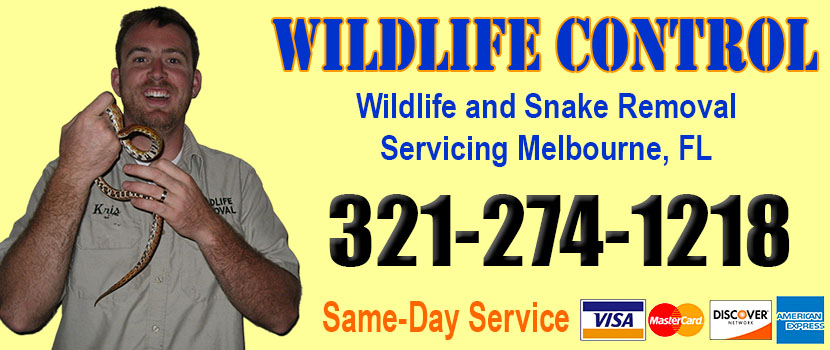
Welcome to melbournesnakes.com! I am David, a snake enthusiast living in Melbourne, FL. Many people don't know that Melbourne is in fact full of snakes! You just need to know where to find them - they can often be shy and elusive. Some Florida snake species are more common outside of the city limits, in different parts of Brevard County FL, but many types of snakes are indeed common in the more urban parts of Melbourne. This guide is meant to help educate you about the beautiful snakes of Melbourne, and to help you identify the most common snakes of Melbourne, as well as the venomous snakes of Melbourne that you should learn to recognize and avoid. If you want more detail, click here for my complete list of ALL snake species in Melbourne. Remember the following:
- Most snakes of Melbourne are harmless and don't want to encounter you
- Venomous snakes exist but are uncommon in Melbourne, Florida
- Snakes eat rats and mice and are a valuable part of the Florida ecosystem
- Never kill a snake - if you leave a snake alone, it will leave you alone.
Common Snake Species in Melbourne
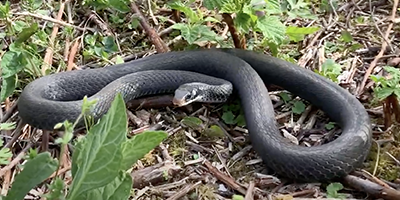 Black Racer:
The black racer (Coluber constrictor priapus) is, as the name suggests, a very fast snake, not to mention a fairly large serpent, with adults growing up to 56 inches (or around 142 cm). As the name tells us, its body has very dark, solid colors, but the black racer’s chin is a distinguished white, which creates an interesting contrast. They usually thrive on lizards, birds, moles, and the like, and prefer dry, bushy areas. It will become violent if you attempt to handle it, so beware!
Black Racer:
The black racer (Coluber constrictor priapus) is, as the name suggests, a very fast snake, not to mention a fairly large serpent, with adults growing up to 56 inches (or around 142 cm). As the name tells us, its body has very dark, solid colors, but the black racer’s chin is a distinguished white, which creates an interesting contrast. They usually thrive on lizards, birds, moles, and the like, and prefer dry, bushy areas. It will become violent if you attempt to handle it, so beware!
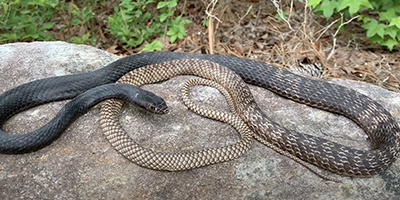 Eastern Coachwhip:
The eastern coachwhip (Masticophis flagellum) is a type of non-venomous snake you’ll find across Florida. It is a long and slender sort of snake when it reaches adulthood, typically growing up to around 72 inches (or 180 cm), a pretty impressive size for a snake! The coachwhip is one of America’s longest snakes, as far as we know. Its head is usually really dark in color (black, mostly) and fades to a pinkish-tan along the body. It’s called a coachwhip because its scaled back resembles a braided whip in appearance. The eastern coachwhip prefers plains and glades as a habitat and mostly feeds on birds, insects, and lizards. Contrary to popular belief, the eastern coachwhip is a fairly reclusive snake and will most likely flee if threatened.
Eastern Coachwhip:
The eastern coachwhip (Masticophis flagellum) is a type of non-venomous snake you’ll find across Florida. It is a long and slender sort of snake when it reaches adulthood, typically growing up to around 72 inches (or 180 cm), a pretty impressive size for a snake! The coachwhip is one of America’s longest snakes, as far as we know. Its head is usually really dark in color (black, mostly) and fades to a pinkish-tan along the body. It’s called a coachwhip because its scaled back resembles a braided whip in appearance. The eastern coachwhip prefers plains and glades as a habitat and mostly feeds on birds, insects, and lizards. Contrary to popular belief, the eastern coachwhip is a fairly reclusive snake and will most likely flee if threatened.
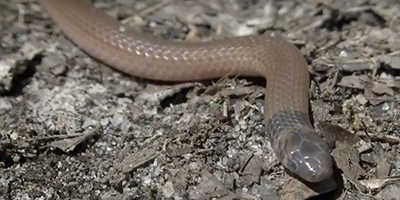 Southeastern Crown Snake:
The southeastern crown snake (Tantilla coronata) is a small type of serpent that is non-venomous and can be found all across the southeastern area of the United States. This serpent is slender in body and only grows up to 10 inches as a fully matured adult (that’s about 25 cm!) Its body is one solid color, usually a pretty earthy, dark shade (e.g. brown or grey). Its head is separated by a yellowish band from the rest of the body and is pointed in shape. The southeastern crown snake has a light belly, usually pink or white. It prefers both damp and dry woodlands and usually feeds on small prey, mostly termites, earthworms, and spiders.
Southeastern Crown Snake:
The southeastern crown snake (Tantilla coronata) is a small type of serpent that is non-venomous and can be found all across the southeastern area of the United States. This serpent is slender in body and only grows up to 10 inches as a fully matured adult (that’s about 25 cm!) Its body is one solid color, usually a pretty earthy, dark shade (e.g. brown or grey). Its head is separated by a yellowish band from the rest of the body and is pointed in shape. The southeastern crown snake has a light belly, usually pink or white. It prefers both damp and dry woodlands and usually feeds on small prey, mostly termites, earthworms, and spiders.
Venomous Snake Species in Melbourne
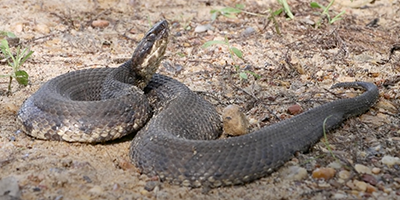 Cottonmouth:
The cottonmouth (Agkistrodon piscivorus leucostoma) is also known as the water moccasin because it can often be found around water sources, such as swamps, lakes, or streams. It is a dark snake, its body usually ranging in earthy colors and darkening with age. It can grow up to 27.5 inches (so roughly 70 cm) and is the smallest of its kind. Although venomous and dangerous, cottonmouths aren’t usually aggressive and prefer to avoid confrontation.
Cottonmouth:
The cottonmouth (Agkistrodon piscivorus leucostoma) is also known as the water moccasin because it can often be found around water sources, such as swamps, lakes, or streams. It is a dark snake, its body usually ranging in earthy colors and darkening with age. It can grow up to 27.5 inches (so roughly 70 cm) and is the smallest of its kind. Although venomous and dangerous, cottonmouths aren’t usually aggressive and prefer to avoid confrontation.
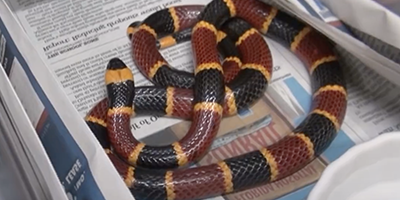 Eastern Coral Snake:
The eastern coral snake (Micrurus fulvius) is a highly venomous type of serpent that can be found across the state of Florida. Its venom is neurotoxic (meaning it causes paralysis and respiratory failure quite rapidly) and highly potent, although eastern coral snake fatalities are rare, given its reclusive disposition. The eastern coral snake is a fairly small serpent, only measuring around 30 inches (80 cm), and is easily distinguished by its red, black, and yellow coloring, which alerts you to danger. It prefers pine woods and flatwoods and feeds mainly on frogs and even smaller snakes.
Eastern Coral Snake:
The eastern coral snake (Micrurus fulvius) is a highly venomous type of serpent that can be found across the state of Florida. Its venom is neurotoxic (meaning it causes paralysis and respiratory failure quite rapidly) and highly potent, although eastern coral snake fatalities are rare, given its reclusive disposition. The eastern coral snake is a fairly small serpent, only measuring around 30 inches (80 cm), and is easily distinguished by its red, black, and yellow coloring, which alerts you to danger. It prefers pine woods and flatwoods and feeds mainly on frogs and even smaller snakes.
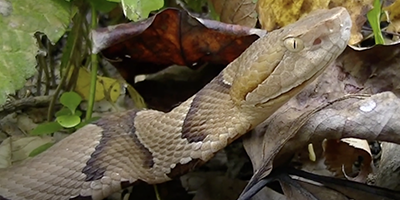 Southern Copperhead:
The southern copperhead (Agkistrodon contortrix) is a venomous type of pit viper that grows up to 37 - 40 inches (or roughly 95 - 100 cm), which is a fairly large size for a snake. Its body is quite stout and it can be distinguished by the flat head, usually larger than the body. The southern copperhead usually has light colors, both in its base, as well as the crossbands and color blotches. It’s usually an earthy, pinkish-tan shade, with the blotches varying in darkness. The southern copperhead favors wooded, rocky areas, and feeds on small rodents. It’s not generally aggressive towards humans.
Southern Copperhead:
The southern copperhead (Agkistrodon contortrix) is a venomous type of pit viper that grows up to 37 - 40 inches (or roughly 95 - 100 cm), which is a fairly large size for a snake. Its body is quite stout and it can be distinguished by the flat head, usually larger than the body. The southern copperhead usually has light colors, both in its base, as well as the crossbands and color blotches. It’s usually an earthy, pinkish-tan shade, with the blotches varying in darkness. The southern copperhead favors wooded, rocky areas, and feeds on small rodents. It’s not generally aggressive towards humans.
If you're unsure, you can email me a photo of the snake at info@melbournesnakes.com and I will email you back with the snake's species. If you found a snake skin, read my Found a Skin? page, and you can email me a photo of the skin, and I'll identify the snake for you. If you need professional Melbourne snake removal help, click my Get Help page, or see the below website sponsor I found, who provides that service.
Remember, the term is not poisonous snakes of Melbourne, it's venomous snakes of Melbourne. Poison is generally something you eat, and venom is injected into you. That said, dangerous snakes are very rare in Melbourne. The few venomous snakes of Brevard County are rarely seen. But they are commonly misidentified, so learn about all the snake species of Melbourne in order to correctly identify them. These snakes are usually also found in the surrounding towns of Melbourne, Palm Bay, Titusville, Cocoa, Cocoa Beach, Merritt Island, Rockledge, Satellite Beach, Melbourne Beach, Cape Canaveral, Indialantic, West Melbourne, Indian Harbour Beach, Micco, Port Saint John, Mims, Malabar, Grant-Valkaria, Palm Shores, Sharpes, Melbourne Village, South Patrick Shores, Cocoa West, Viera West, June Park and the surrounding areas.
Read our article about:
Baby Snakes and Snake Eggs
melbournesnakes.com domain and hosting costs made possible by the generous support of this sponsor:
